|
Sunday,
July 31, 2011
 The
Loneliness of the Long Distance Commuter
- I recently returned from a trip to the Washington, D.C. The
Loneliness of the Long Distance Commuter
- I recently returned from a trip to the Washington, D.C. 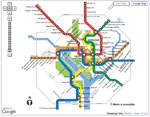 area.
I go every few years to visit family. I usually try to plan some
activity that will take me to some Civil War battlefields and this
trip was no exception. But, more on that later. area.
I go every few years to visit family. I usually try to plan some
activity that will take me to some Civil War battlefields and this
trip was no exception. But, more on that later.
While there, I took two metro
trips into town. That's the map to the right. It seems
reasonably efficient and I don't mind riding it. I don't want to
think about how much it cost and whether or not it was worth taxpayer
money. And, I don't want to think about the fact that the
government runs this operation. Indeed, there is a proposal to
add another line - the Purple
Line - and quite a bit of opposition
to it.
But, what I noticed, once again, was how solitary the riders
were. Virtually everyone, especially during the rush hour
commute to work, was a sole rider. And, while the car was jam
packed with people, everyone maintained his/her own distinct eco-vironment
(that's probably not a word, so when it is, remember I coined
it!). That is, people were engaged in their own personal
activities - reading a book, reading a paper, reading a Kindle,
or doing games, reading, or e-mail on their phones. And, kept
their eyes averted from making contact with anyone else. It was
really quite bizarre. Apparently, it is a violation of common
courtesy to look around at people. Which is what I did.
But, not that much. I tended to look out the window a lot.
When you get to the tunnels, that is pretty boring!
So, why is it that in this place of socialization, people do not
socialize? Sure, there must be some unsavory folks here, but I
suspect most are OK people. I guess it is because people feel
like they are forced to socialize because of their need for this
transportation.
You do see a difference during the off-peak hours when there are more
tourists. They are in bigger groups and tend to be much more
chatty. You also see this at the shuttles up at the Grand Canyon
(where everyone on board is a tourist!). So, it must have
something to do with how voluntary the experience is - the less so,
the more one isolates themselves.
|
|
Tuesday, August
16, 2011
 The
Civil War @ 150
- I was visiting family back in the Washington, D.C. area and, as
I am wont to do, I made sure to see some Civil War sites. As
luck would have it, this year marks the beginning of 4 years of events
commemorating 150 years since that time, and the biggest kickoff was
going to be a re-enactment of the Battle of Manassas/Bull Run.
Over 8,000 re-enactors were participating in this event, and I was
able to go. We arrived early - The
Civil War @ 150
- I was visiting family back in the Washington, D.C. area and, as
I am wont to do, I made sure to see some Civil War sites. As
luck would have it, this year marks the beginning of 4 years of events
commemorating 150 years since that time, and the biggest kickoff was
going to be a re-enactment of the Battle of Manassas/Bull Run.
Over 8,000 re-enactors were participating in this event, and I was
able to go. We arrived early -
|
Click
on any photo to see a larger image. |
|

Early
morning arrivals at the Union Camp.
|

Dawn breaks
over the Union camp.
|
a bit after 6 a.m., caught a
shuttle to the grounds (about 2 miles from the actual 1861 battle, but
relatively close to the the site of the 1862 battle). There were
bleachers and standing room areas and the place was packed to the
gills. It was a hot and humid week in the nation's capitol, and
free water was being constantly distributed. Since this was the
real start to many more such commemorative events, I decided to ask
the editor of my local paper if he'd be interested in a story.
He was, and it ran
on Sunday, August 7. Here is the article, along with some of
my photos:
|
The
Civil War: Let the re-enactments begin
Dennis Foster
In the early afternoon of July 21, 1861, Captains Ricketts and
Griffin marshal their artillery batteries into position to
attack the unsupported flank of Colonel Thomas Jackson’s
brigade. The thunderous roar of the Federal cannon fills
the air. The Confederate cannon respond in kind.
Smoke covers the field as the first major battle of the Civil
War rages on over the plains of Manassas.
|

Confederate
forces (foreground, left) trade gunfire
with Union troops in the early morning battle.
|

Confederate
forces are outnumbered and are
soon to retreat from Matthews Hill.
|
During a scorching week this past July, over eight thousand
participants have come to a small town in Virginia to help
commemorate the 150th anniversary of the Battle of Manassas,
the first large scale conflict of the Civil War. They
have come to re-enact the battle, wearing period clothing,
armed with period weapons and giving the tens of thousands
that have come to watch a brief glimpse of life during that
turbulent time. They are living in camps on the grounds
and spend time practicing battle formations. As we walk
around the encampments in the early morning hours, you can
half close your eyes and feel as if you have been transported
back in time. Some soldiers are starting to get up,
while others stoke small fires. Others are practicing
drills, while a blacksmith is already hard at work.
We marvel at the bravery and courage of men thrust into war.
We know that there are no bullets, and that the cannon fire
blanks, but still we feel some of the realism of the actual
event. We follow the successes and failures of both
sides, as this is a war among ourselves. We can extol
the virtue of men fighting for what they believe in, for a
cause that unites them, even if the reasons for war, as is so
often the case, are flawed.
*****
Earlier in the day Federal forces, commanded by Colonel
Burnside, marched around the Confederate left and crossed the
Bull Run nearly undetected. They were slowed down when
Generals Bee and Bartow rallied their men to make a stand on
Matthews Hill. With the entry of Colonel Sherman’s
brigade, the Confederate lines crumbled and they retreated to
nearby Henry Hill, where Colonel Jackson had just deployed his
men. Jackson’s Virginians stopped the Federal forces,
earning him the famous nickname of “Stonewall” Jackson.
|

Last
of the Confederate forces engaged in
battle before giving up Matthews Hill.
|

Following
the Union success at Matthews Hill,
a lull was punctuated by an artillery duel.
|
Of course the issue of slavery is unrelentingly entwined into
the birth of the Civil War. Clearly, it was the driving
force for secession in the seven states of the deep South that
left the Union before President Lincoln even assumed office.
However, this motivation becomes more complicated for four
other slave states that refused to secede until hostilities
broke out and President Lincoln called for the raising of an
army to quell the rebellion by force. And, even with
one-third of the states in secession, there still remained
four other slave states that remained with the Union.
Likewise, when it comes to the personalities involved, the
issue of slavery was convoluted in a way that today we can
hardly understand. The sitting Vice President under
Lincoln owned slaves at the outset of the war. General
Grant had owned at least one slave in the late 1850s.
Confederate General Longstreet owned no slaves. General
Pickett, who led a futile charge at Gettysburg, not only
didn’t own slaves, but was vocal in his opposition to this
execrable institution.
Indeed, if the Civil War had ended with a Federal victory that
day near Manassas, it isn’t clear that slavery wouldn’t
have persisted for years, or decades, to come, as Lincoln had
no initial intention of challenging slavery in the existing
slave states. It wasn’t until the fall of 1862, with
the issuance of the Emancipation Proclamation that abolishing
slavery became a formal goal of Union efforts in winning the
war.
Today, we have the luxury of knowing how the Civil War turned
out and that the terrible price, paid in blood, bought an end
to slavery. Consequently, we can be more detached and
relive the battles, immerse ourselves in the tactics and
strategies of the two opposing armies, while acknowledging
Robert E. Lee’s famous words, “It is well that war is so
terrible lest we should grow too fond of it.”
*****
The battle seesawed throughout the afternoon, but the arrival
of fresh Confederate troops tipped the balance and broke the
Federal attack. As their lines came apart, the retreat
turned chaotic and Major Stuart led his cavalry in pursuit.
This attack was met by Major Sykes’ U.S. Regular Infantry,
which formed an “infantry square,” a defensive formation
that ended the attack and allowed the Federal forces to
withdraw.
|

The
battle for Henry Hill with Confederate forces
(under Jackson), on the left, hold off Union
advance.
|

Union
lines begin to break as fresh Confederate
forces are thrown into battle.
|
The events commemorating the 150th anniversary of the Civil
War will continue for the next four years. They will
offer innumerable opportunities for us to study and
contemplate this period of our history. And, at the end
of the day, we can recall these words from President
Lincoln’s second inaugural address, “With malice toward
none, and charity for all . . . let us strive on . . . to bind
up the nation’s wounds.”
*****
Dennis Foster has lived in
Flagstaff for more than 20 years, but was born in Washington,
D.C. He has maintained a strong interest in the Civil
War and has visited many of its battlefields.
For more information:
The
National Park Service maintains most of the Civil War
battlefields and will be offering many commemorative events.
Find out more on their web page:
http://www.nps.gov/civilwar150/
You can
find a more comprehensive listing of Civil War activities
here:
http://www.civilwar.org/150th-anniversary/
Perhaps
the most notable re-enactment will occur at Gettysburg, in
2013. Keep up with this event through their Visitors’
Bureau:
http://www.gettysburg.travel/
To read
more on the Civil War, James McPherson’s Battle
Cry of Freedom is an excellent place to start.
To learn
about the individual battles of the Civil War, The
Civil War Battlefield Guide, published by The Conservation
Fund is an indispensable resource.
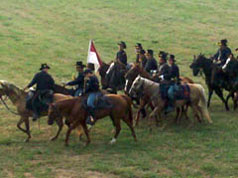
Cavalry on parade. |
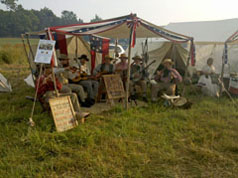
The 2nd So.
Carolina String Band. |
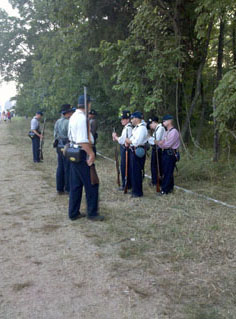
A small unit
of Union infantry do
some early morning drilling
in preparation for the
coming battle.
|
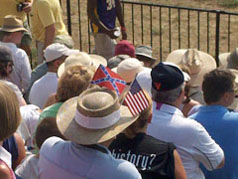
Hard not to
root for both sides! |

Stonewall
Jackson statue. |
|
A few additional comments . . .
 Jackson
a general. I
relied on the official program for military rank - Burnsides &
Sherman were both colonels at this time. But, later I read that
Jackson had been promoted to general a month before the battle.
So, I missed that. Also, I identified Bartow as a general,
although he was a colonel at the time of battle. He died shortly
after being wounded during the battle and was the first brigade
commander to die in the Civil War. He was posthumously made a
general, so I thought it fitting to refer to him that way.
Jackson
a general. I
relied on the official program for military rank - Burnsides &
Sherman were both colonels at this time. But, later I read that
Jackson had been promoted to general a month before the battle.
So, I missed that. Also, I identified Bartow as a general,
although he was a colonel at the time of battle. He died shortly
after being wounded during the battle and was the first brigade
commander to die in the Civil War. He was posthumously made a
general, so I thought it fitting to refer to him that way.
 Slavery. As
I point out in my article, slavery was an undeniable motive force in
inciting the Civil War. Yet, today Confederate re-enactors, and
those that embrace their southern heritage, would have nothing to do
with slavery. Instead, they focus on other aspects of what is
often referred to as the "War of Northern Aggression."
And, I for one, am glad they do. While some deride Confederate
symbols as synonymous with slavery, others have pointed out that
slavery existed for more years under the "stars and stripes"
than it did under the "stars and bar." Additionally,
if slavery is the one single criteria for judging the moral worth of
the cause of the Confederacy, consider that such a criteria would tend
to make our victory in the Revolutionary War regrettable. After
all, Britain abolished slavery in the 1830s, and if we had lost that
contest in 1776, perhaps slavery would have ended earlier for
us. Food for thought.
Slavery. As
I point out in my article, slavery was an undeniable motive force in
inciting the Civil War. Yet, today Confederate re-enactors, and
those that embrace their southern heritage, would have nothing to do
with slavery. Instead, they focus on other aspects of what is
often referred to as the "War of Northern Aggression."
And, I for one, am glad they do. While some deride Confederate
symbols as synonymous with slavery, others have pointed out that
slavery existed for more years under the "stars and stripes"
than it did under the "stars and bar." Additionally,
if slavery is the one single criteria for judging the moral worth of
the cause of the Confederacy, consider that such a criteria would tend
to make our victory in the Revolutionary War regrettable. After
all, Britain abolished slavery in the 1830s, and if we had lost that
contest in 1776, perhaps slavery would have ended earlier for
us. Food for thought.
 Blacks
were in attendance. There
were some blacks at this event, and some even participating in period
costumes. Not in large numbers, to be sure, but I think more
than you would see at a NASCAR race, or at the Grand Canyon. At
the battle re-enactment site, and for the overall commemoration, there
were a number of events that focused on blacks during the Civil War,
whether slave or free. One fascinating story in this regard
involves "Gentleman"
Jim Robinson, a free black man living on his farm at Henry Hill.
Blacks
were in attendance. There
were some blacks at this event, and some even participating in period
costumes. Not in large numbers, to be sure, but I think more
than you would see at a NASCAR race, or at the Grand Canyon. At
the battle re-enactment site, and for the overall commemoration, there
were a number of events that focused on blacks during the Civil War,
whether slave or free. One fascinating story in this regard
involves "Gentleman"
Jim Robinson, a free black man living on his farm at Henry Hill.
|
|
Friday, August
19, 2011
 Perry-Romney
2012 - I
don't really
know much about Rick Perry, and I can't say that I really trust Mitt
Romney to hold to free market principles, but I am rather attracted to
the idea of this pairing for the next presidential election. I
haven't really looked around to see if anyone else has opined on this match up,
so it is not likely to be much of an original thought with me.
Still, I like the idea of a businessman (or, woman) as a member of the
national ticket, and so I like Romney in the supporting role. I
know that the press has taken Perry to task for his recent comments on
the Fed and man-made global warming, but I found his comments
refreshingly honest. So, while my enthusiasm may not last
(exactly what did happen to Gary Johnson's invisible campaign??), I
offer up this preliminary bumper sticker (ah, if only you could
download it into your LCD
device!) along with some miscellaneous comments: Perry-Romney
2012 - I
don't really
know much about Rick Perry, and I can't say that I really trust Mitt
Romney to hold to free market principles, but I am rather attracted to
the idea of this pairing for the next presidential election. I
haven't really looked around to see if anyone else has opined on this match up,
so it is not likely to be much of an original thought with me.
Still, I like the idea of a businessman (or, woman) as a member of the
national ticket, and so I like Romney in the supporting role. I
know that the press has taken Perry to task for his recent comments on
the Fed and man-made global warming, but I found his comments
refreshingly honest. So, while my enthusiasm may not last
(exactly what did happen to Gary Johnson's invisible campaign??), I
offer up this preliminary bumper sticker (ah, if only you could
download it into your LCD
device!) along with some miscellaneous comments:
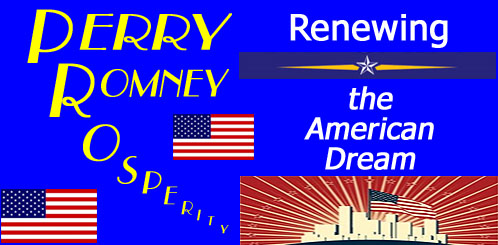
 Prosperity. I
think that the key to the next election will revolve around the
economy and what the electorate finds most compelling (again, not
exactly rocket science). I pondered about how to play off the P
and R in their names and was considering "Prosperity &
Revitalization." Yuck. I was put off by the idea of
it standing for "public relations," but opponents will
probably find that a suitable come back. In the end, I liked
that I could use the P and R together.
Prosperity. I
think that the key to the next election will revolve around the
economy and what the electorate finds most compelling (again, not
exactly rocket science). I pondered about how to play off the P
and R in their names and was considering "Prosperity &
Revitalization." Yuck. I was put off by the idea of
it standing for "public relations," but opponents will
probably find that a suitable come back. In the end, I liked
that I could use the P and R together.
 Renewing
the American Dream. I
was considering "restoring" instead, but didn't like the
idea that it just argues for a return to the good old days, since
there is plenty to complain about them! I settled on
"renewing" because it allows one to be forward looking and
yet argue for a reinvigoration of all that we like about the
"American Dream."
Renewing
the American Dream. I
was considering "restoring" instead, but didn't like the
idea that it just argues for a return to the good old days, since
there is plenty to complain about them! I settled on
"renewing" because it allows one to be forward looking and
yet argue for a reinvigoration of all that we like about the
"American Dream."
 The
shining city on the hill. OK,
I stole that visual from Ronald Reagan's famous allegory. In
fact, I stole the image (I mean, made fair use of that image) from
some Reagan site. I tried to make the path of
"Prosperity" lead to that idealized "shining city on
the hill."
The
shining city on the hill. OK,
I stole that visual from Ronald Reagan's famous allegory. In
fact, I stole the image (I mean, made fair use of that image) from
some Reagan site. I tried to make the path of
"Prosperity" lead to that idealized "shining city on
the hill."
 The
star. OK,
I also stole the star. From the McCain campaign of 2008.
The
star. OK,
I also stole the star. From the McCain campaign of 2008.
|
|
Monday,
September 19, 2011
 Random
Fragments - I
should probably do more of these, but so it goes . . . Random
Fragments - I
should probably do more of these, but so it goes . . .
 If
it's not a choice, it's not a problem. I
recently bought a Samsung Galaxy Tab, WiFi only. I got it
because I got my dad the same thing, but with 3G service so he could
connect to the web through something other than his obsolete
If
it's not a choice, it's not a problem. I
recently bought a Samsung Galaxy Tab, WiFi only. I got it
because I got my dad the same thing, but with 3G service so he could
connect to the web through something other than his obsolete 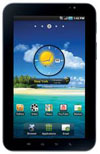 dial
up modem and laptop with Windows 95! I spent a couple of days
learning how it works and then drove up to Denver and spent a couple
of days with him going over features (he really likes to do on-line
banking). OK, insofar as it goes. But, when I ask him
about it, and he tries to explain what happens when he makes certain
selections, I had trouble following him, even though its Android
system is quite similar to my smart phone. So, I got one for me,
but I don't need the 3G so I just got the WiFi model. Turns out
to be a bit of a mistake. Some operating differences, and, as I
have come to find out, some connection problems. Apparently,
when my wireless router has to make some IP changes, the Samsung won't
figure that out and it gets hung up trying to connect. From what
I have read on the web, I might have to do a factory reset, or I might
have to find some special software that will allow me to detect and
delete the cached file that the Samsung is storing the IP address in,
or something else. Anyway, after reading about this in three, or
four, on-line forums, I went to the Samsung site to see if there was
info out there. Nothing!!?! So, I decided to fill out an
e-mail from their help section. It required me to identify the
type of item, make, and model number. But, when I chose mobile
device and wifi tablet, it wouldn't give me a choice for model number
nor let me enter one. Consequently, it wouldn't take my
e-mail!!! Aargh!!! So, I chose a Sprint smart phone
instead and in my message I wrote that "This is not what I
have!!!! But, you won't let me choose what I have!!!" and
so on. We'll see. Seems like I should be able to do a work
around, but maybe a pain in the . . . samsung! dial
up modem and laptop with Windows 95! I spent a couple of days
learning how it works and then drove up to Denver and spent a couple
of days with him going over features (he really likes to do on-line
banking). OK, insofar as it goes. But, when I ask him
about it, and he tries to explain what happens when he makes certain
selections, I had trouble following him, even though its Android
system is quite similar to my smart phone. So, I got one for me,
but I don't need the 3G so I just got the WiFi model. Turns out
to be a bit of a mistake. Some operating differences, and, as I
have come to find out, some connection problems. Apparently,
when my wireless router has to make some IP changes, the Samsung won't
figure that out and it gets hung up trying to connect. From what
I have read on the web, I might have to do a factory reset, or I might
have to find some special software that will allow me to detect and
delete the cached file that the Samsung is storing the IP address in,
or something else. Anyway, after reading about this in three, or
four, on-line forums, I went to the Samsung site to see if there was
info out there. Nothing!!?! So, I decided to fill out an
e-mail from their help section. It required me to identify the
type of item, make, and model number. But, when I chose mobile
device and wifi tablet, it wouldn't give me a choice for model number
nor let me enter one. Consequently, it wouldn't take my
e-mail!!! Aargh!!! So, I chose a Sprint smart phone
instead and in my message I wrote that "This is not what I
have!!!! But, you won't let me choose what I have!!!" and
so on. We'll see. Seems like I should be able to do a work
around, but maybe a pain in the . . . samsung!
 NAU
9/11 flag flap. Some
of my students were handing out small American Flags at the University
Union last Friday, in commemoration of 9/11. They had a permit
to set up a table outside for this. Then, it started raining and
they moved inside, staying out the way and continuing with their
activity. Then, the powers that be
NAU
9/11 flag flap. Some
of my students were handing out small American Flags at the University
Union last Friday, in commemoration of 9/11. They had a permit
to set up a table outside for this. Then, it started raining and
they moved inside, staying out the way and continuing with their
activity. Then, the powers that be  descended
upon them. The quick-witted organizer filmed it and put it up on
YouTube.
The story was picked up by Drudge and showed up in a Fox News blog as
well as a Townhall
blog. The local paper ran a front
page story on it as well. Much of the local response is both
predictable and inane. This shouldn't even have been an
issue. The school officials should have just found a way to
accommodate this group of students - did I mention that there were 3
of them? Just looking around, there were more students
congregating in ad hoc groups than these three. And, did I
mention that these were small flags that you can hold in your hand, or
maybe tape to your pencil? Clearly, they represented a threat to
the public order. I haven't checked recently, but I thought that
at Tiananmen Square, the rule was to break up groups of five or
more. Perhaps, officials at NAU can relax their standards and
adopt the more liberal Chinese rule? But, that's not how
bureaucrats think. And, certainly that's not how they think when
it comes to conservative students. It's too bad we can't just
have a "Use Common Sense" rule! Later, I was talking
with a student about this issue and was told that in the morning there
are usually 20-40 students lined up in this very space, at the
Starbucks, blocking the doors and congesting the whole area.
Nobody ever comes out to ask for their permit. descended
upon them. The quick-witted organizer filmed it and put it up on
YouTube.
The story was picked up by Drudge and showed up in a Fox News blog as
well as a Townhall
blog. The local paper ran a front
page story on it as well. Much of the local response is both
predictable and inane. This shouldn't even have been an
issue. The school officials should have just found a way to
accommodate this group of students - did I mention that there were 3
of them? Just looking around, there were more students
congregating in ad hoc groups than these three. And, did I
mention that these were small flags that you can hold in your hand, or
maybe tape to your pencil? Clearly, they represented a threat to
the public order. I haven't checked recently, but I thought that
at Tiananmen Square, the rule was to break up groups of five or
more. Perhaps, officials at NAU can relax their standards and
adopt the more liberal Chinese rule? But, that's not how
bureaucrats think. And, certainly that's not how they think when
it comes to conservative students. It's too bad we can't just
have a "Use Common Sense" rule! Later, I was talking
with a student about this issue and was told that in the morning there
are usually 20-40 students lined up in this very space, at the
Starbucks, blocking the doors and congesting the whole area.
Nobody ever comes out to ask for their permit.
  Katrina
made me do it! I
was watching John Stossel's most excellent show, Stupid
in America. He raised the point that there are now more
kids in charter schools in New Orleans than in public schools.
The reason? Hurricane Katrina. It wiped out so much
infrastructure that the city was pretty much forced to allow for
competition (i.e., capitalism) in order to meet their education
needs. Hmm . . . quite a lesson here, but nobody else seems to
be talking about it! Indeed, he had one commentator remark about
how we tend to reinvent ourselves after such natural catastrophes, and
he cited the San Francisco earthquake and the Chicago fire as
additional examples. But, of course this is disingenuous.
It misses the point that it takes a natural disaster to finally allow
us to throw off the shackles of corrupt government and give the market
a chance to bloom, reinvigorating our lives. If only we could
learn that lesson without having the natural disasters!!
Katrina
made me do it! I
was watching John Stossel's most excellent show, Stupid
in America. He raised the point that there are now more
kids in charter schools in New Orleans than in public schools.
The reason? Hurricane Katrina. It wiped out so much
infrastructure that the city was pretty much forced to allow for
competition (i.e., capitalism) in order to meet their education
needs. Hmm . . . quite a lesson here, but nobody else seems to
be talking about it! Indeed, he had one commentator remark about
how we tend to reinvent ourselves after such natural catastrophes, and
he cited the San Francisco earthquake and the Chicago fire as
additional examples. But, of course this is disingenuous.
It misses the point that it takes a natural disaster to finally allow
us to throw off the shackles of corrupt government and give the market
a chance to bloom, reinvigorating our lives. If only we could
learn that lesson without having the natural disasters!!
|